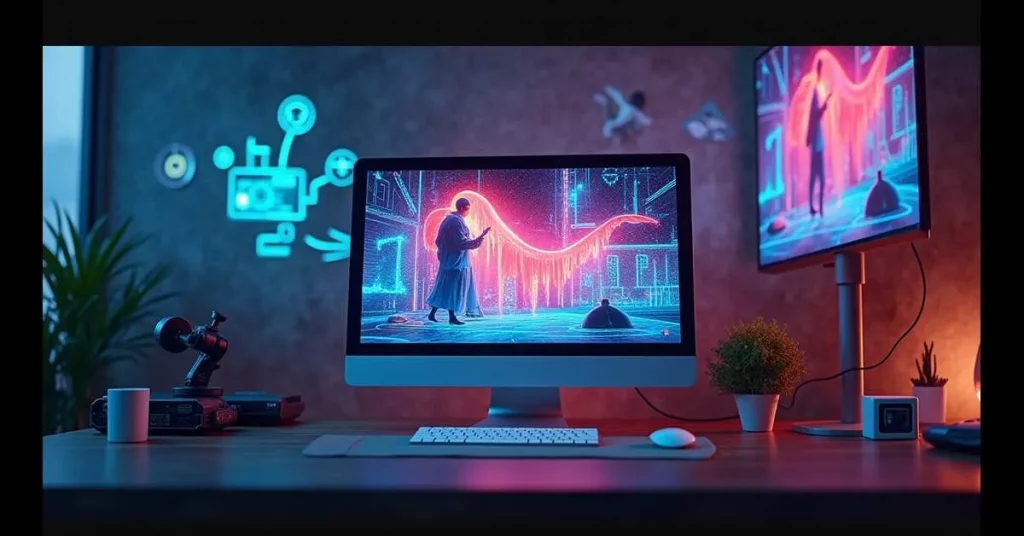Product demo videos don’t tell. They show. They’re perfect for today’s fast-moving, short-attention-span audiences who decide in microseconds whether to keep watching or scroll away. That’s why demo videos have become a go-to strategy for smart brands. They let you instantly highlight what makes your product valuable, turning curious viewers into engaged prospects.
In fact, 95% of marketers now say video is essential to their strategy, up from 88% just last year. More businesses are using demo videos to boost engagement, spark real interest, and position their products as must-have solutions.
Still, there’s one big challenge: knowing where to start. Over a third of marketers (37%) admit they want to use video but feel stuck at square one. This is where a pro animated product demo video shines. Whether your audience is scrolling through TikTok, watching on YouTube, or visiting your website, they can be engaged everywhere if done right.
What is an Animated Product Video?

A product demo video is a short, powerful way to visually show how your product works, why it matters, and the benefits it delivers. A demo video helps businesses connect with their audiences easily and effectively by letting them see the product in action. That clarity builds trust and helps turn curiosity into real buying intent. In just a few seconds, your audience can understand:
- How your product works
- Which features matter most
- Why does it make life easier
- What it looks like in real-world use
Why Are Product Demo Videos Relevant in 2026?

An animated product video is more than just eye-catching content. When done right, it works as a conversion machine, moving your audience from top-of-funnel curiosity to middle-of-funnel confidence (moving from curiosity to confidence) in just a minute.
In the United States alone, 97.8% people watch online videos. That makes product demos one of the most direct ways to connect with potential customers. When your demo clearly shows value, it does more than educate. It helps transform curious viewers into paying customers. Now let’s look at how to make a product demo video that makes it happen.
Step 1: Identify & Understand Your Audience With Precision
Don’t stop at basic demographics like age or location. Today’s viewers expect personalization. To create demo videos, go deeper and understand your audience’s job roles, responsibilities, pain points, motivations, goals, and media habits. These insights help you decide the tone, length, style, and everything else of your demo video.
Set Clear, Measurable Goals
Not every demo has the same purpose. Decide early whether your primary goal is to drive conversions, build trust, or educate your audience through your product demo. It’s because a demo meant to boost trial sign-ups will be structured differently from one focused on increasing brand awareness.
Match Complexity to Audience Expectations
Your target viewers’ knowledge level should dictate how deep you go in your product demos:
- Tech-savvy audiences: They appreciate a detailed walkthrough that highlights advanced features and integrations.
- General consumers: They prefer a simple and clear explanation that shows immediate benefits without any frills.
- B2B decision-makers: They care less about flashy visuals and more about ROI. So highlight business outcomes and case studies if possible.
- First-time buyers: They respond best to straightforward demos that focus on ease of use, quick setup, and real customer testimonials.
- Millennial and Gen Z shoppers: They engage with fast-paced, visually dynamic demos that blend storytelling with social-media-ready snippets.
Step 2: Prepare Your Script
Script and storyline determine whether people care about your demo. The first 5 to 10 seconds are everything. So, first you need to present a problem and then tease a solution. You can use surprise or contrast to grab attention for an even better hook.
Keep Language Natural and Human
Speak the way your audience thinks. For consumer products, use everyday words. For B2B or technical tools, keep things precise but avoid drowning in jargon.
Highlight Pain Points and Real Solutions
Show the previous state and emphasize the pain and frustration. Then transition into the after state and demonstrate how the product helped. This arrangement in your product demo convinces the audience to think your product is worth their attention.
Build Emotion Through Relatable Storytelling
Facts inform, but stories sell. That is why you need to use characters or personas in your demos that your audience can relate to. It implies that they should be able to relate to those characters and reflect their everyday life struggles. This helps viewers picture themselves using your product—and that’s often enough to close the deal.
Structure the Flow Logically
Your demo should be like a journey. It should flow logically and emotionally, like movies do, making complete sense. Begin by showing the problem your audience is facing and then smoothly introducing your product as the solution. After that, highlighting the key features and benefits, and then displaying the before and after states of using your product. Then comes a CTA, and your demo is perfect.
It sounds simple, but it’s trickier than it looks. So, if you want a team that can build this kind of flow for your brand, Swift Animation is here to craft demos that turn attention into action.
Step 3: Visualize with a Storyboard
Finally comes one of the trickiest and most time-consuming steps. Note that a storyboard is the bridge between your script and the final animated product demo video, transforming your words into a visual roadmap that shows exactly how the story will unfold, scene by scene. Without it, you risk misaligned visuals, confusing pacing, and costly revisions later.
To start with this step, you need to break your script into scenes, sketching what the audience will see and hear alongside. Think rough drawings, stick figures, or digital mockups—they’re enough.
Define On-Screen Elements
Note that each element has a job in your product demo video. Here’s what each element does:
- Visual Emphasis: Determine what the audience should be paying attention to at that time. This may be the product, a character or the environment.
- Text & Captions: Short text reveals the context of the animation and also works in sync with the voiceover, allowing the mobile audience to watch the animation without sound.
- Icons, Graphics or Motion Cues: We are familiar with icons and graphics, but motion cues (such as an arrow sliding onto the screen) is equally relevant for animation, drawing eyes to specific details.
- Transitions: Soft cuts such as fades (when you want a smooth change), zooms (when you want to focus on detail), or swipes (when you want to pass through steps) make the video look natural.
Map the Pacing and Rhythm
Speed, pauses, and transitions are just as important as the visuals themselves. Here’s what you can do to fix this.
- Where to slow down: Pause or extend when presenting a key feature or advantage so it sticks. For example, if your product automates invoices, give viewers a few extra seconds to explore the interface, read a caption, or watch the automation in action.
- Where to speed up: Move quickly through supporting features or smaller details to keep the story engaging. A rapid montage of things like integrations, design options, or color variations works well here.
- How long each scene should last: Think of each scene like a sentence in a conversation—short enough to be remembered, long enough to be clear. As a guide, feature highlights typically run 3–7 seconds, while transformations or benefits may need 8–12 seconds.
- Use pacing for emotion: Pacing sets the tone. Faster pacing creates energy and excitement. Slower pacing builds emphasis and clarity. For instance, a Gen Z-focused product might use quick cuts and snappy edits, while business software benefits from a steadier pace to avoid overwhelming the audience.
Align Visuals to the Narrative
Your visuals are the emotional translator of your script. That’s why every scene should visually echo the story you’re telling so the audience feels the message, not just hears it.
- Problem scenes: Use visuals that let viewers instantly recognize the pain point. This could be a cluttered desk covered in papers, a user clicking with no result, or muted colors signaling frustration and hard work.
- Solution scenes: When introducing the product, shift the mood. Brighten the colors, simplify the background, and show smooth, satisfying movement. For example, where there were once piles of disorganized paperwork, now there’s a clean, intuitive digital dashboard.
- Call-to-action scenes: End on a confident, welcoming note. Use bold typography, upbeat music, and strong product visuals. Keep the background uncluttered so the focus lands on the CTA button, tagline, or website link.
- Why this matters: Trust and conversions depend on emotional alignment. Your video shouldn’t make viewers work to decode the concept. They should simply feel the shift from problem to solution.
Step 4: Choose the Animation Style
Your animation style is more than an aesthetic choice. In today’s digital-first market, especially in the U.S., viewers expect polished, brand-consistent visuals that both engage and inform. Always check: Does this style feel like my brand? Would my audience expect this look from us?
Here are a few simple style choices to match your product and message:
- If your product needs detail, go 3D.
- If your message is abstract, use motion graphics.
- If your audience craves connection, lean into live-action hybrids.
- If you’re showcasing lifestyle or accessibility, 2D animation is your friend.
- If you want maximum immersion, consider AR or interactive formats.
Step 5: Showcase Features and Benefits Clearly
The most important thing in a high-converting product demo is clarity. The confused viewer will move on, and the clear and purposeful demo will create trust and push them closer to making a purchase. That is why you need to show features in action, rather than just describing them in words. In a product demo, rather than stating Our app lets you check out with one click, have a character who taps once and immediately gets a confirmation. The action proves the claim.
Always Translate Features Into Benefits
Features by themselves don’t sell. But benefits do. Modern U.S. audiences want to know what’s in it for them. To help you understand this easily, here’s a rule of thumb: every feature shown should immediately answer the viewer’s silent question, “How does this make my life easier, better, or more enjoyable?”
Keep the Pacing Brisk and Intentional
The average U.S. online viewer has a short attention span. If a demo drags, they’ll drop off. You need to move faster through supporting or secondary features—use quick cuts, highlights, or overlays. Also, use motion cues like arrows, highlights, and zooms to guide the eye, so viewers never wonder where to look.
Layer Clarity With Accessibility
Modern audiences consume video everywhere, like on phones, laptops, smart TVs, and even wearables. So, add on-screen text or captions to reinforce key points (and serve viewers watching without sound).
Step 6: Design for Engagement
Even the best script and sharpest benefits won’t land if the animation feels flat. Engagement in animated product demos comes from how visuals move, how text is styled, how sound supports the story, and how smooth the overall flow feels. In today’s U.S. digital culture, where people scroll in seconds, design is what makes a demo stand out, be remembered, and get shared.
Elevate Animation Quality
The first rule of a great animated demo is clarity. Make each scene easy and to the point with one obvious point, either a feature, benefit, or call-to-action. Let natural effects, such as morphs, fades, zooms, etc., lead the viewer rather than flash effects that draw attention away. Be consistent with your brand and use your colors, shapes, and motion style throughout. As an example, a fintech brand could go heavy on sharp geometric motion with cool blues to be accurate and credible, whereas a wellness app could go light on rounded forms and calming gradients to have a feeling of ease.
Typography That Works Visually
One of the easiest methods of increasing impact in your animated demo is through animated on-screen text. Use clean and modern fonts, which are easy to read on the mobile phone, and make them big enough to fit on TikTok or Instagram. Use short and strong sentences, such as Save Time or One-Click Setup instead of a complete sentence. This is important since most Americans view videos on social media with the sound off, and on-screen text makes your message sink in a few seconds.
Audio That Completes the Experience
Sound can either ruin or save your animated demo. A confident and clear voice best fits B2B software, and a more casual and conversational tone better fits Gen Z eCommerce. Include background music that supplements, not dominates, be it upbeat as part of lifestyle, ambient for SaaS, upbeat for fitness. Lastly, add small sounds such as whooshes, clicks, or pings to focus on. Imagine that audio is seasoning; it must add to the experience, it must never replace it.
Editing for Flow and Energy
Each movement in your demo must seem intentional, and the movement must be smooth to bring the eye along rather than jump around. Think through the animation—go slowly to highlight clickbaity features it has and accelerate with smaller details to ensure that the rhythm keeps up with short attention spans without rushing. Be consistent in motion speed, color palette, and audio levels, since inconsistent animation feels amateur and breaks trust.
Optimize for Platforms
To reach as many people as possible, develop both widescreen formats on YouTube and websites and vertical formats on TikTok, Instagram, and Shorts. Always have captions; not only do captions ensure your demo is accessible and meets the ADA requirements, but they also increase the watch time, which is what audiences in the U.S. are demanding today.
Step 7: Drive Action, Stay Organized, and Keep Improving
Finally, we’ve reached the last step—and it’s a critical one. So far, you have learned enough to create demo videos. A winning animated demo doesn’t just launch and sit idle. It drives action, follows a clear process, and keeps improving with every insight you gather. That mix of strong CTAs, smart organization, and ongoing refinement turns your video into a growth engine instead of a one-and-done project.
Guide viewers with clear CTAs. A demo without direction is like a road without signs. Add calls-to-action at moments of peak engagement, not just at the end. Keep them short and action-focused with phrases like Try it free or Book a demo. In 2026, audiences expect frictionless next steps—clickable links, QR codes, or one-tap actions built right into the video.

Final Words
One of the quickest ways to turn interest into sales is through product demo videos. They demonstrate how your product works, answer customer questions before they are asked and make the value obvious in a few seconds. Demo videos provide a way to build trust through visuals and real-world value, which motivates buyers to stop browsing and start buying, making them an essential part of digital marketing today.
FAQs
1. How long should my animated product demo be?
Stick to 60 to 120 seconds—long enough to cover the essentials, short enough to keep attention.. Smaller videos are more efficient at capturing and retaining the attention of modern viewers.
2. Is animation better than live-action for demo videos?
It depends. Animation makes complicated concepts easier to understand, is less expensive to update, and allows you to control all the visuals. Live-action gives credibility to people. Use animation when you need clarity and flexibility, live-action when you need emotional realism.
3. What’s the biggest hurdle when making an animated demo?
Honestly, it’s the script. Unless the story is clear, the entire video may fail. It’s far cheaper to get it right from the start. This is why at Swift Animation, we assist you in developing a script that is sharp, natural, and constructed to convert.
4. Why am I losing viewers so early in my demo?
A viewer loses interest very quickly when the speed is too slow or the tone is too technical. Make images alive, words natural, and always lead with benefits over features. Contact Swift Animation, and we will correct you.
5. Will animated demos still work in an era of AI and short-form content?
Yes. But they have to evolve. Demo styles are shifting with AI tools and snackable short-form content. The trick remains to mix interesting narration with rapid and sharp visuals to keep the interest.


